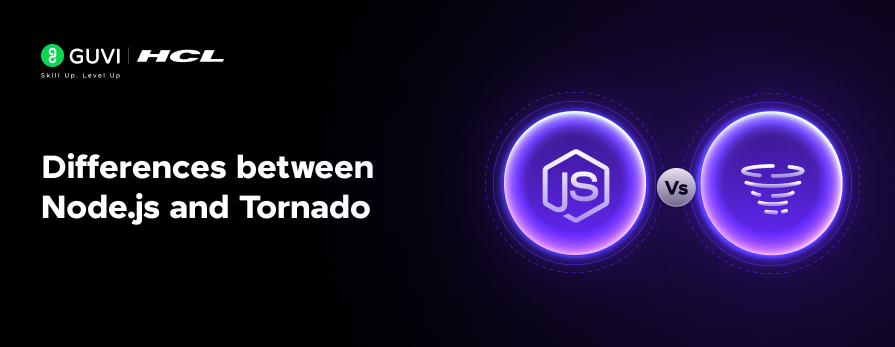
If you’re diving into the world of web development, you’ve probably come across Node.js and Tornado. Both are powerful tools for building high-performance web applications, but choosing between them can feel overwhelming. Should you go with Python Tornado or JavaScript Node.js? Which one performs better?
Don’t worry! In this blog, we’ll break down the Node.js vs Tornado performance, compare their real-world uses, and help you decide which is the best fit for your project—all with easy explanations and relatable examples.
Table of contents
- Differences Between Node.js and Tornado
- What is Node.js?
- Example of Node.js (Express server):
- Why choose Node.js?
- What is a Tornado?
- Example of Tornado server:
- Why choose Tornado?
- Node.js vs Tornado Performance
- Conclusion
- FAQs
- Which is faster: Tornado or Node.js?
- Is Tornado better than Express?
- Should I choose Python Tornado or JavaScript Node.js?
- Is Tornado still used today?
Differences Between Node.js and Tornado
At first glance, Node.js and Tornado both help you build fast, scalable web applications. But they are quite different under the hood:
| Feature | Node.js | Tornado |
| Language | JavaScript | Python |
| Asynchronous Support | Built-in via event-driven model | Built-in via coroutine model |
| Popularity | Extremely popular, vast ecosystem | Niche, focused on high performance |
| Use Case | Real-time apps (chat, games, APIs) | High-concurrency services (API gateways, microservices) |
| Framework Ecosystem | Express, Koa, NestJS | Native Tornado modules |
| Learning Curve | Easy for JS developers | Steeper, Python-centric |
Now let’s take a closer look at each.
What is Node.js?
Node.js is a runtime environment that lets you run JavaScript outside the browser. It’s designed for building scalable network applications and is best known for powering apps like Netflix, LinkedIn, and Uber.
Example of Node.js (Express server):
const express = require(‘express’);
const app = express();
app.get(‘/’, (req, res) => {
res.send(‘Hello from Node.js!’);
});
app.listen(3000, () => {
console.log(‘Server running on http://localhost:3000’);
});
In this example, we used Express, a popular framework. If you’re comparing Tornado vs Express, Express is lightweight, fast, and extremely easy to use.
Why choose Node.js?
- Massive package ecosystem (via npm)
- Perfect for real-time apps
- Smooth learning curve for frontend developers
What is a Tornado?
Tornado is a Python web framework and asynchronous networking library. It’s designed to handle thousands of simultaneous connections, making it ideal for long polling, WebSockets, and other high-concurrency scenarios.
Example of Tornado server:
import tornado.ioloop
import tornado.web
class MainHandler(tornado.web.RequestHandler):
def get(self):
self.write(“Hello from Tornado!”)
def make_app():
return tornado.web.Application([
(r”/”, MainHandler),
])
if __name__ == “__main__”:
app = make_app()
app.listen(3000)
tornado.ioloop.IOLoop.current().start()
Why choose Tornado?
- Great for long-lived network connections
- Seamless async programming in Python
- Good choice for microservices and API gateways
Node.js vs Tornado Performance
When it comes to Node.js vs Tornado performance, both are fast, but in different ways:
- Node.js is optimized for I/O-heavy applications and real-time interactions (think chat apps).
- Tornado shines when you need to handle massive concurrency with minimal latency (think API servers handling thousands of requests per second).
So, for raw speed, they can be close, but your use case matters. If you already love Python, Python Tornado vs JavaScript Node.js becomes more about language preference and ecosystem than raw speed.
Want to explore JavaScript in-depth? Do register for GUVI’s JavaScript self-paced course where you will learn concepts such as the working of JavaScript and its many benefits, Variables, Objects, Operators, and Functions, as well as advanced topics like Closures, Hoisting, and Classes to name a few. You will also learn concepts pertaining to the latest update of ES6.
Conclusion
To wrap up, the choice between Node.js and Tornado boils down to:
- Use Node.js if you want a vast ecosystem, easy learning curve, and robust support for real-time apps.
- Use Tornado if you’re dealing with high-concurrency Python projects and want rock-solid performance for microservices or long-polling connections.
Both are incredible tools. But understanding your project’s needs and your team’s skillset will lead you to the right choice in the Tornado vs Node.js comparison.
FAQs
In terms of raw speed, Node.js vs Tornado performance is very comparable. Tornado may handle high concurrency better, while Node.js is better for I/O-heavy, real-time apps.
Comparing Tornado vs Express, it’s apples to oranges. Tornado is a full framework and networking library in Python, while Express is a minimalistic Node.js framework.
If you love Python and need high concurrency, go with Tornado. If you’re building real-time apps or already using JavaScript, Node.js is ideal.
Yes! While niche, Tornado is still actively maintained and used in projects requiring high performance, especially with Python.





















Did you enjoy this article?